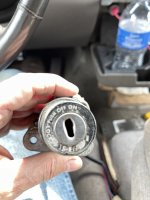Here's a link to a switch overhaul thread ......
http://www.xs650.com/threads/ignition-switch-overhaul.46712/
While the pics are pretty good, the guy leaves out some key points in his description, and more importantly, he doesn't do a complete job. He only disassembles the bottom portion of the switch and doesn't pull the lock cylinder out. He was praised for the write-up but I rate it as only fair. But, you can use it to get the thing disassembled down to the lock cylinder. Once you do, this is what you'll see .....
The spring will lift out revealing the sliding lock wafer that DB mentioned. Note it's orientation. If we call the slot on the upper left where the wires enter the top or 12 o'clock, you want the lock wafer pointing to around 7 o'clock. It's possible to install the lock cylinder with the lock wafer pointing in the opposite direction, 180° off. If you do that, the fork lock will still operate but you won't be able to remove the key in the "Lock" or "Park" position .....
Press the lock wafer into the lock cylinder with a small screwdriver or pick .....
..... and the lock cylinder will slide out the top .....
Note the side of the cylinder that the wafers spring out of (for proper re-assembly insertion). They pop out towards the "Ignition" label, not the "On-Off" one. Once the cylinder is out, it needs to be cleaned up. The wafers get all crusty. Here's some from a lock I did recently. The 3 on the right have been polished clean and shiny with a little wire wheel in a Dremel. The 2 on the left are how they came out (pretty crusty) .....
Then I pack the cleaned lock cylinder full of white lithium grease and re-assemble .....

